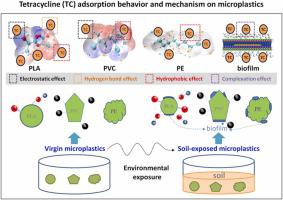Journal of Hazardous Materials ( IF 12.2 ) Pub Date : 2022-08-13 , DOI: 10.1016/j.jhazmat.2022.129770 Kai Wang 1 , Ting Han 1 , Xiaodong Chen 1 , Iranzi Emile Rushimisha 1 , Yonghong Liu 2 , Side Yang 1 , Xinyu Miao 3 , Xiaojing Li 1 , Liping Weng 1 , Yongtao Li 4

|
Microplastics (MPs), as vectors of pollutants, have attracted extensive attention because of their environmental effects. However, the adsorption behavior and antibiotic mechanism of environmentally exposed MPs is limited. Here, the adsorption of tetracycline (TC) onto virgin and soil-exposed polylactic acid (PLA), polyvinyl chloride (PVC) and polyethylene (PE) MPs showed that the adsorption capacity of MPs for TC increased after soil exposure, and PLA showed the strongest increase. Soil exposure increased the time to reach equilibrium, and the adsorption rate was controlled by both intraparticle diffusion and membrane diffusion. The isothermal adsorption results of soil-exposed PE and PLA indicated that TC adsorbed on heterogeneous surfaces was affected by the physicochemical adsorption process. The equilibrium absorption capacity of MPs for TC increased by 88% (PLA), 26% (PVC) and 15% (PE) after soil exposure. Soil dissolved organic matter promoted the desorption of TC from MPs, and TC speciation changed with pH. Soil-exposed MPs have the potential to promote TC degradation in solution without the addition of biological inhibitors. Moreover, density functional theory calculations verified that PE and PVC adsorbed TC through physical interactions, while hydrogen bonds were formed on PLA with TC. These results clarified the behavior and mechanisms of TC adsorption on virgin and soil-exposed MPs, which can help in the risk assessment of concomitant pollution of MPs and antibiotics.
中文翻译:

对四环素在原生和土壤暴露微塑料上的吸附行为和机制的见解
微塑料(MPs)作为污染物的载体,因其对环境的影响而受到广泛关注。然而,环境暴露的 MPs 的吸附行为和抗生素机制是有限的。在这里,四环素 (TC) 在原始和土壤暴露的聚乳酸 (PLA)、聚氯乙烯 (PVC) 和聚乙烯 (PE) MPs 上的吸附表明 MPs 对 TC 的吸附能力在土壤暴露后增加,PLA 表现出最强的增长。土壤暴露增加了达到平衡的时间,吸附速率受颗粒内扩散和膜扩散的控制。土壤暴露的PE和PLA的等温吸附结果表明,TC吸附在异质表面上受物理化学吸附过程的影响。MPs 对 TC 的平衡吸收能力在土壤暴露后增加了 88% (PLA)、26% (PVC) 和 15% (PE)。土壤溶解的有机物促进了 TC 从 MPs 中解吸,TC 形态随 pH 值而变化。在不添加生物抑制剂的情况下,暴露于土壤的 MPs 有可能促进溶液中的 TC 降解。此外,密度泛函理论计算证实,PE和PVC通过物理相互作用吸附TC,而PLA与TC形成氢键。这些结果阐明了 TC 在原始和土壤暴露 MPs 上的吸附行为和机制,有助于对 MPs 和抗生素伴随污染的风险评估。和 TC 形态随 pH 值而变化。在不添加生物抑制剂的情况下,暴露于土壤的 MPs 有可能促进溶液中的 TC 降解。此外,密度泛函理论计算证实,PE和PVC通过物理相互作用吸附TC,而PLA与TC形成氢键。这些结果阐明了 TC 在原始和土壤暴露 MPs 上的吸附行为和机制,有助于对 MPs 和抗生素伴随污染的风险评估。和 TC 形态随 pH 值而变化。在不添加生物抑制剂的情况下,暴露于土壤的 MPs 有可能促进溶液中的 TC 降解。此外,密度泛函理论计算证实,PE和PVC通过物理相互作用吸附TC,而PLA与TC形成氢键。这些结果阐明了 TC 在原始和土壤暴露 MPs 上的吸附行为和机制,有助于对 MPs 和抗生素伴随污染的风险评估。











































 京公网安备 11010802027423号
京公网安备 11010802027423号